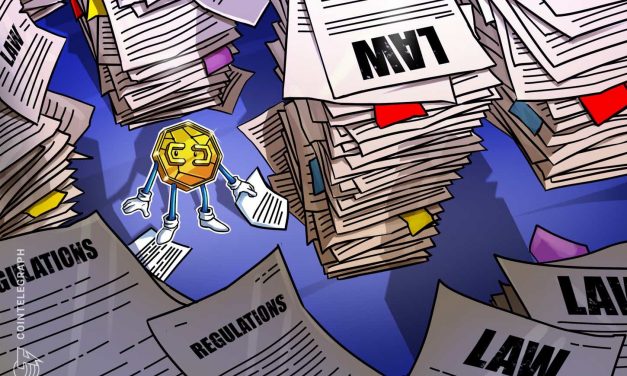DeFi resolving the five flaws of traditional finance, book review
Writing a book on decentralized finance is a bit like describing a riddle, wrapped in a mystery inside an enigma, to borrow from Winston Churchill. First, one must summarize the origins of modern decentralized finance, then the mechanics of the blockchain technology that provides the sector’s backbone, and only then do you arrive at DeFi’s infrastructure. It all should be done in 191 pages, too, including glossary, notes and index. It is not an undertaking for the faint of heart.Fortunately, the authors of DeFi and the Future of Finance — Duke University finance professor Campbell Harvey, Dragonfly Capital general partner Ashwin Ramachandran, and Fei Labs founder Joey Santoro — were up to the task. After recapitulating the “five flaws of traditional finance” — inefficiency, limited access, opacity, centralized control and lack of interoperability — they go on to explain how DeFi improves upon the status quo. Take the problem of centralized control. Governments and large institutions hold a “virtual monopoly” over the money supply, rate of inflation, as well as “access to the best investment opportunities,” wrote the authors. DeFi with its open protocols and immutable properties “upends this centralized control.” As for how DeFi answers traditional finance’s opacity shortcoming: “All [DeFi] parties are aware of the capitalization of their counterparties and, to the extent required, can see how funds will be deployed,” which mitigates counterparty risk. As goes inefficiency, “A user can largely self-serve within the parameters of the smart contract” in a decentralized application by exercising a put option, for instance. What about traditional finance’s failing in limited access? DeFi gives underserved groups like the world’s unbanked population direct access to financial services, wrote the authors, offering yield farming as an example, a DeFi process where users are rewarded for staking capital in the form of a governance token that makes them, in effect, part-owners of the platform, “a rare occurrence in traditional finance.”The authors also described the ways that DeFi protocols can be layered atop one another (i.e., DeFi’s composability, sometimes referred to as “DeFi Legos”), which helps to deal with the interoperability deficit. Once a base infrastructure has been established (to create a synthetic asset, for instance), “any new protocols allowing for borrowing or lending can be applied. A higher level would allow for attainment of leverage on top of borrowed assets.”Taking a deep diveChapter 6 explores eight leading DeFi protocols in depth: MakerDAO, Compound, Aave, Uniswap,Yield, dYdX, Synthetic, and Set Protocol. Each section is accompanied with a very useful table, where the first column describes how traditional finance solves a particular problem, and the second column how a specific DeFi protocol deals with that problem.For example, in Table 6.3, “Problems that Aave Solves,” the first row deals with “centralized control.” In the incumbent finance system, “borrowing and lending rates [are] controlled by institutions,” whereas in the DeFi approach, Column 2, “Aave interest rates are controlled algorithmically.” Related: Tech transformation: Don Tapscott’s ‘Platform Revolution’ book reviewTraditional finance provides only “limited access” within its legacy systems. That is, “only select groups have access to large quantities of money for arbitrage or refinance” (Row 2, Column 1), while within the Aave protocol, “flash loans democratize access to liquidity for immediately profitable enterprises.”The third row focuses on “inefficiency,” specifically “suboptimal rates for borrowing and lending due to inflated costs” in traditional finance, while Aave’s solution (Row 3, Column 2) is “algorithmically pooled and optimized interest rates.”Novel risksThe authors were careful to remind readers that “all innovative technologies introduce a new set of risks.” In the case of DeFi, these are abundant, including smart contract, governance, oracle, scaling, DEX custodial, environmental and regulatory risks. “Software is uniquely vulnerable to hacks and developer malpractice,” the authors wrote, while recent hacks of bZx and DForce “demonstrate the fragility of smart contract programming.”Among these new threats, “oracle risk” looms particularly large. DeFi protocols require access to accurate, secure price information to ensure that actions such as liquidations and prediction market resolutions work smoothly. “Fundamentally, oracles aim to answer the simple question: How can off-chain data be securely reported on chain?” Yet, all online oracles as currently constituted “are vulnerable to front-running, and millions of dollars have been lost to arbitrageurs,” they wrote, adding: “Until oracles are blockchain native, hardened, and proven resilient, they represent the largest systemic threat to DeFi today.”Raising up “marginalized groups”“This book is fundamentally about financial democracy,” co-author Harvey told Cointelegraph. The book’s preface, written by no less a personage as Ethereum creator Vitalik Buterin, reminds readers that “financial censorship continues to be a problem for marginalized groups,” especially in the developing world — which is why DeFi is important. The average reader might find this book a bit heavy on the technical side, however. Graphics include superlinear and logistic/sigmoid bonding curves, for example, which might go over some heads. Those who want to learn how a flash loan actually works, though, will find it useful; the book’s glossary is comprehensive and helpful. Related: DeFi: A comprehensive guide to decentralized financeIt would have been illuminating, however, to learn more about how DeFi was beginning to actually change the world, such as offering banking to the unbanked, or insurance to the uninsured — though perhaps this is beyond the scope of the book. One might ask what percentage of the world’s “unbanked population” is actually taking advantage of “yield farming,” a still-esoteric DeFi process that the authors nonetheless cite as an example of the way DeFi provides access “to the many who need financial services but whom traditional finance leaves behind.” Not too many, one guesses.Unfortunately, much of the focus in the DeFi world today still seems to be on ways to gain leverage or arbitrage between markets rather than solving the problems of the global poor. Nor does the book devote much ink to defending DeFi from critics in the general business press such as The Wall Street Journal, which noted in September that DeFi was “bringing casino capitalism to the crypto masses.” That is not the authors’ vision of the future. On the contrary, they see in DeFi “the scaffolding of a shining new city. […] Finance becomes accessible to all. Quality ideas are funded no matter who you are. A $10 transaction is treated identically to a $100 million transaction. Savings rates increase and borrowing costs decrease as the wasteful middle layers are excised. Ultimately we see DeFi as the greatest opportunity of the coming decade and look forward to the reinvention of finance as we know it.”These are worthy goals, though unlikely to be realized in the immediate future. Until then, this book should be of interest to anyone looking to unravel DeFi’s inner workings.
Čítaj viac



